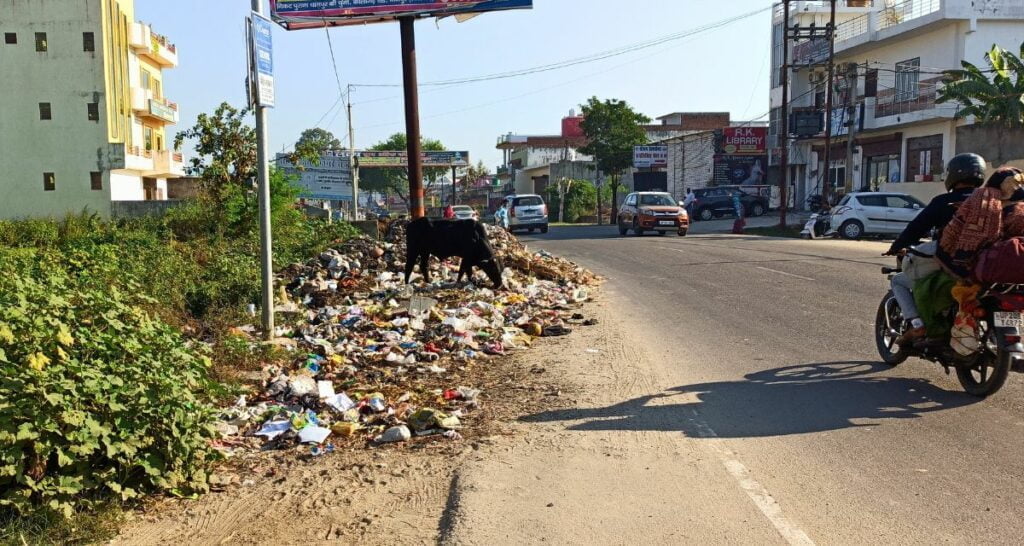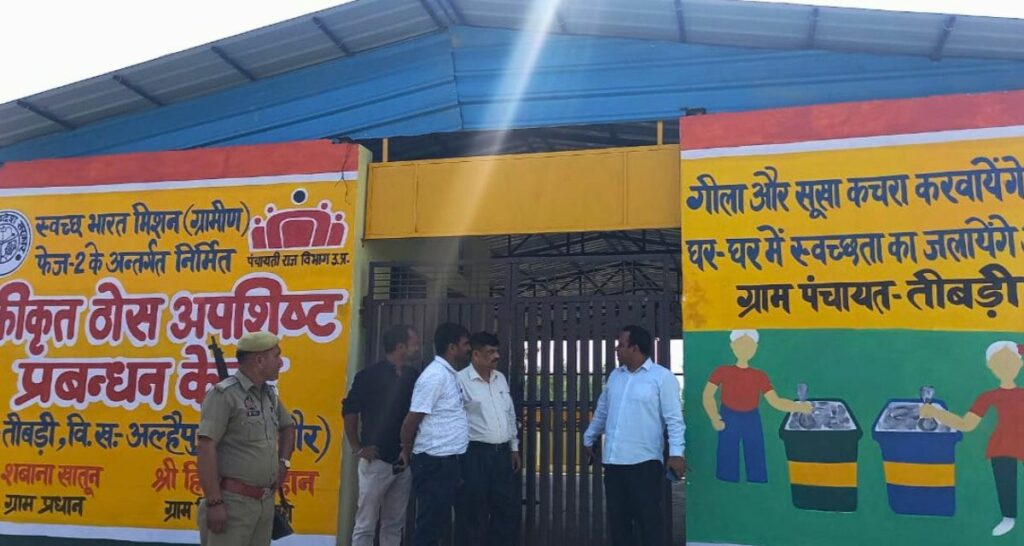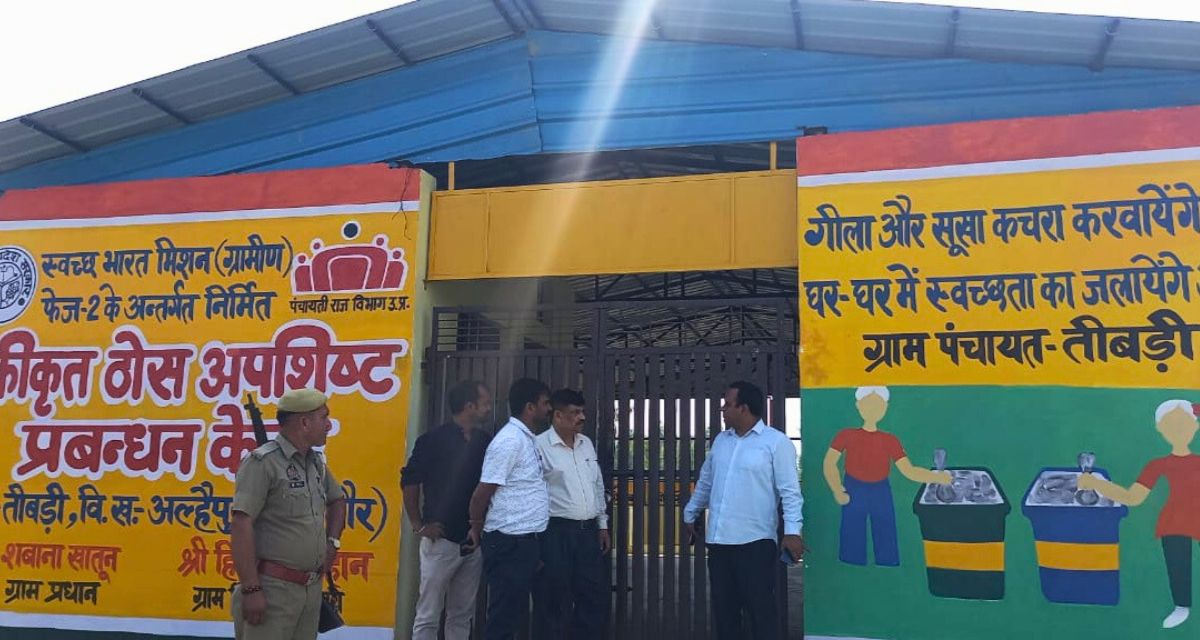While women workers strive to keep Tibri village spic and span, there are other places like Ditanpur where garbage mounds and foul smell are the order of the day
By Shahbaz Anwar
Dhampur, Uttar Pradesh: Sitting in the middle of a mound of garbage, Hanso Devi (38) is sorting dry waste from wet waste. There is an overpowering smell of decomposing waste, but Hanso’s hands are working tirelessly. ‘This is where my money is,’ she says wryly.
‘We will earn by selling iron and plastic items in the waste people throw away. The panchayat secretary will pay us at the end of the month,’ she says.

Hanso is among the seven women hired by the panchayat office of Tibri village in Allehpur (Dhampur) block of Uttar Pradesh’s Bijnor district to maintain manure and compost pits as part of the Swachh Bharat Mission-Grameen (SBM-G), panchayat secretary Himanshu Chauhan tells 101Reporters.

‘They segregate waste and play a crucial part in maintaining cleanliness in the village. They sell to scrap dealers whatever scrap metal or plastic they find in the garbage. These women receive 60 per cent of the proceeds from selling reclaimed metal items, while the remaining 40 per cent is deposited in the panchayat’s account,’ Chauhan details.
A plus point
Waste disposal initiatives were launched in the villages included in the Open Defecation Free (ODF) Plus scheme launched last year. ‘In the first phase of the scheme, 49 of the 1,124 panchayats in Bijnor districts were selected, including Dhampur and Tibri in Allehpur block,’ Allehpur’s Assistant Development Officer Naseem Ahmed tells 101Reporters.
Naseem says the first phase (2022-23) of the ODF Plus scheme covered gram panchayats with a population of over 5,000. In the second phase, 84 villages in the block are slated for inclusion.
Chauhan informs that the Uttar Pradesh government designated a 15 x 8 m sq plot of land provided by the revenue department and located within the village for the initiative. ‘A budget of Rs 13,82,000 was sanctioned for various activities. The allocated land now hosts a waste disposal centre comprising nine sections, facilitating segregation of various types of waste such as glass, cardboard, plastic, iron and more.’
Vegetables and fruit peels are composted at the community compost pit set up on this land. Other wet waste gets buried in the ground.

According to Chauhan, every woman is estimated to get Rs 5,000 to 6,500 after the sale of scrap. ‘When I heard about this job, I signed up as my husband’s income is not sufficient to meet our household expenses. This work helps in managing our household expenses,’ says Rajwati Devi (42), one of the seven women workers.
Holistic approach
The commencement of the ODF Plus scheme marks a holistic approach to cleanliness. This includes diverse initiatives such as door-to-door garbage collection, setting up of garbage disposal centres and establishment of manure and compost pits.
Traditionally, each village appoints a sanitation worker responsible for upholding cleanliness. ‘Additional workers can be enlisted with the approval of the village head and panchayat secretary in villages with large populations if the sanitation worker finds it challenging to handle the workload alone,’ Naseem says.
Under ODF Plus, the number of sanitation workers is higher. ‘This is because they not only collect garbage from every household but also play a crucial role in segregating dry and wet waste,’ he adds.
According to Ditanpur village head Nafees Ahmed, three sanitation workers cater to a population of 5,000 in his village. ‘Considering the presence of two-gram panchayats in my area and its considerable geographical expanse, the number of sanitation workers is more. They work from 7 am to 2 pm during summers and from 8 am to 3 pm in winter,’ Nafees says.
Talking about the expenditure, Nafees explains, ‘A designated percentage of the funds allocated for developmental projects in the village is specifically earmarked for the cleanliness system. Over five years, our gram panchayat covering Jeetanpur and Alawalpur has been granted approximately Rs 1 crore. As a result, an annual allocation of about Rs 6 lakh is directed towards cleanliness in our gram panchayat.’

In contrast, Anil Kumar, a former Assistant Development Officer, observes that the standard annual development budget for a gram panchayat falls within the range of Rs 20 to 25 lakh. Typically, 30 per cent of the amount is designated for cleanliness, with specific allocations varying among different villages.
Roadblocks at Allehpur
Though on the right track, SBM-G faces several roadblocks ahead. A part of the Allehpur block manages its waste under the ODF Plus scheme, while the other areas still grapple with the problem of garbage accumulation along the highways.
According to Monu Kumar, a resident of Ditanpur, the garbage crisis in his village is only increasing. ‘I am deeply troubled by this garbage pile. Villagers dispose of their household waste here, making it unbearable to stay indoors due to the foul smell. Recently, we found a snake in our house, which might have landed here from the garbage heap. Despite multiple complaints to the authorities, no action has been taken.’
Continuing along the same route, approximately 200 m away, another sizeable garbage mound poses a potential health hazard near a settlement. While the authorities say lime and pesticides are regularly sprayed in such areas, doctors argue that the accumulation of waste encourages the breeding of mosquitoes and other insects, which are carriers of diseases.
‘The presence of garbage and filth poses a significant risk of cholera, jaundice and other potentially life-threatening illnesses,’ says BK Snehi, in-charge medical officer, at Seohara Community Health Centre.
Allehpur Block Development Officer Trilokchand tells 101Reporters that the initiatives to establish garbage disposal centres are going on in different villages. ‘Comprehensive efforts are being made to address this issue promptly. When complaints about garbage heaps are received, additional cleaning staff are deployed and measures are implemented to ensure cleanliness,’ he claims.
Shahbaz Anwar is a Uttar Pradesh-based freelance journalist and a member of 101Reporters, a pan-India network of grassroots reporters.
About the author(s)
101Reporters is a pan-India network of grassroots reporters that brings out unheard stories from the hinterland.





